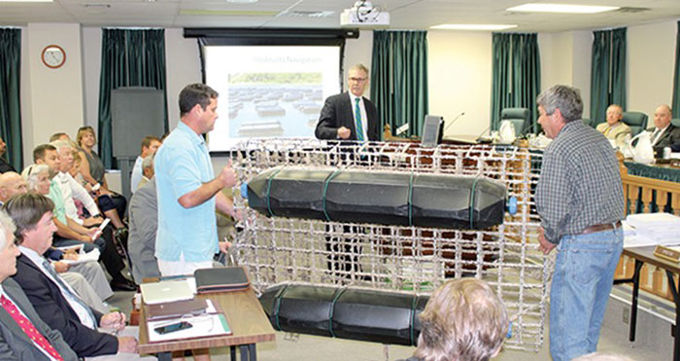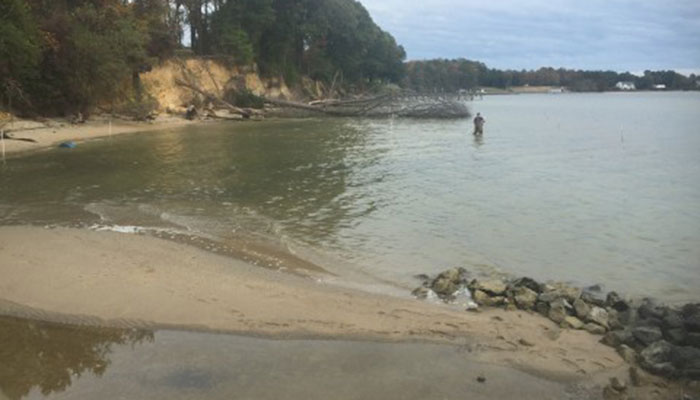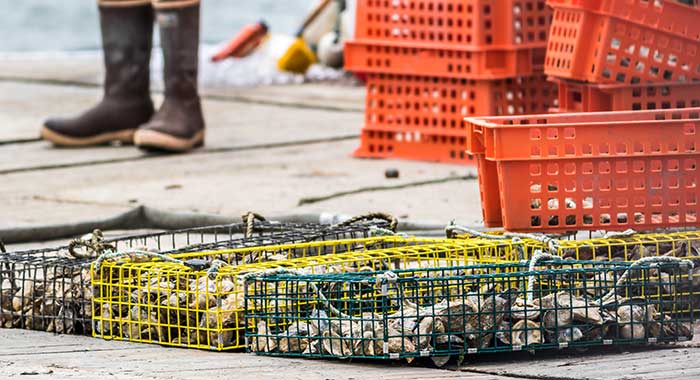
VA Riparian & Waterfront Property Rights at April 2019 VMRC Meeting
“VMRC decisions have direct and immediate consequences affecting the riparian property rights of Virginia's waterfront property owners. The VMRC makes these decisions at monthly meetings which are open to public. We attend the monthly VMRC meetings to represent our clients or as observers, and provide our readers a summary of the important cases.”
The Virginia Marine Resources Commission (VMRC) is the state agency that manages Virginia’s marine resources. The VMRC regulates the fisheries and shellfish industries and issues permits for encroachments over state-owned submerged lands. It also manages the Virginia Wetlands Act, and the Coastal Primary Sand Dune Protection Act. VMRC decisions have direct and immediate consequences affecting the riparian property rights of Virginia's waterfront property owners. The VMRC makes these decisions at monthly meetings which are open to public. We attend the monthly VMRC meeting to represent our clients or as observers, and provide our readers a summary of the important cases.
The April meeting of the Virginia Marine Research Commission was held on April 23, 2019 in the VMRC’s offices located on Fort Monroe in Hampton, Virginia. Seven Commission members were present; Associate Commissioners Ed Tankard and Christy Everett were absent.
After unanimously passing two non-contested infrastructure applications, one to add 24 pier piles to the expansion of the High Rise Bridge over the Southern Branch of the Elizabeth River and the second to allow maintenance dredging of Rudee Inlet, the Commission received a briefing from Doctor Mark Luckenbach of the Virginia Institute of Marine Science (VIMS). Dr. Luckenbach briefed the Commission on a study that VIMS has launched to assess the interaction of oyster aquaculture and submerged aquatic vegetation (SAV). Specifically, Dr. Luckenbach stated that the purpose of the study is to develop “Best Management Practices” for the co-existence of oyster aquaculture and SAV. He stated that the study is directed by Governor Northam’s Aquaculture Working Group, which was established in August 2018, and is described in an August 2018 post on this blog. Commissioner Bowman reiterated that the study is directed by Governor Northam and Secretary Strickler.
By way of background, at its July 2017 meeting, the Commission approved a guidance document entitled Submerged Aquatic Vegetation (SAV) Guidance: Criteria Defining SAV Beds and Delineating Areas Where There is Potential for SAV Restoration. The SAV Guidance adopted in 2017 states that the VMRC will “avoid authorization of any new structure, including aquaculture structures on unleased bottoms, and any new activity, or leasing oyster planting grounds on any SAV bed annually mapped by VIMS during at least 1 of the previous 5 years.” Dr. Luckenbach noted that, pursuant to the Guidance, VMRC will not grant a new oyster lease on bottom where SAV has been mapped, nor will it grant a permit for floating aquaculture on bottom where SAV has been mapped, and the Commission will not allow installation of any additional oyster aquaculture equipment if SAV “invades” an area that was without SAV at the time that the oyster lease was granted.
Dr. Luckenbach described the ways in which oyster aquaculture harms SAV (damage from cages, damage from trampling, propeller damage, loss of sunlight due to shading, over-enrichment from bio-deposits). He also described ways in which oyster aquaculture benefits SAV (improved water clarity, reduced sedimentation, traps shoots and seeds, moderate-enrichment from bio-deposits).
Dr. Luckenbach, concluded by outlining the study methodology, which is to identify two industry partners who are requesting permits in an SAV area. His hope is that the Commission will grant “experimental” permits to these two industry partners so that VIMS can gather data on the extent to which the oyster aquaculture activities impact the SAV. A primary purpose of the study is, in Dr. Luckenbach’s words, to determine whether the VMRC’s current policy, as reflected in the 2017 SAV Guidance, is “overly restrictive”.
David L. Stearns (JPA #19-0188)
This is an appeal of the decision by the Norfolk Wetlands Board to approve Mr. Stearns’ request to replace 97 feet of failing bulkhead and to convert 375 square feet of non-vegetated wetlands to vegetated wetlands.
The project does not require a permit from the VMRC because the project takes place on privately-owned bottom, it having been created as part of a man-made boat basin. Instead, the project comes before the VMRC because, pursuant to Virginia Code §28.2-1311, the VMRC is the first level of appeal for decisions of a local wetlands board.
There were two grounds stated in the appeal.
First, the appellants argued that Mr. Stearns should install a riprap revetment, instead of a bulkhead as this would further the goals of reducing erosion and helping to control flooding. It was clear from the record, however, that the Norfolk Wetlands Board considered both of these options before approving the bulkhead. As such, the decision of the Norfolk Wetlands Board was not “arbitrary and capricious” and should therefore be upheld.
Second, the appellants argued that Mr. Stearns did not have clear title to portions of the property where the project would go forward. However, the VMRC believes that it is without jurisdiction to decide property boundary disputes.
The VMRC affirmed the decision of the Norfolk Wetlands Board on a unanimous 7-0 vote (Associate Commissioners Ed Tankard and Christy Everett were absent).
Grayland Horn (JPA #18-1656)
Mr Horn owns an 8-acre undeveloped site with 600 feet of shoreline on the north shore of the Rappahannock River, one-half mile upstream of the Route 3 Norris Bridge. This 600 foot shoreline is being hit with high energy wave action, due to a fetch in a southeasterly direction of 8 miles to the mouth of the river and over 25 miles across Chesapeake Bay to the Eastern Shore. It is the last unarmored property along this reach of the river. Tremendous bank erosion has created a 20 foot cliff, with the mean high water line reaching the base of the cliff, and numerous large trees having fallen into the river as a result of the severe bank erosion, all of which is evident in this photo:

VMRC
Mr. Horn proposes to stabilize his shoreline by installing two 210-foot long quarry stone beakwaters 75’ channelward, grade the cliff 40 feet landward, extend the slop channelward to attain a 4:1 slope, and then use the sand salvaged from the grading of the cliff to fill the area landward of the breakwaters to an elevation above mean high water to create a small beach between each end of the breakwater and the proposed spurs. Mr. Horn will plant 100 trees upland and will vegetate the beach area (created channelward of the breakwaters) with American Beach Grass. Doing this will create a 600’ living shoreline without bulkheading and without riprap revetment. As such, this project is highly beneficial for the environment and is in line with the policy that “encourages the use of living shorelines as the preferred alternative for stabilizing tidal shorelines in the Commonwealth.” Va. Code §28.2-104.1(B).
The two sticking points both relate to SAV – albeit a lower quality species of SAV – that is growing in the area that Mr. Horn proposes to fill. First, the project runs counter to the VMRC’s 2017 SAV Guidance, which guidance was discussed previously in this blog post. Second, if the project is allowed to proceed, the VMRC’s Subaqueous Guidelines indicate a preference for “compensatory mitigation” to balance the loss of SAV. At $2 per square foot of SAV loss, the Staff recommended approval of the project in exchange for a $14,189.82 payment from Mr. Horn.
Commissioner Bowman observed that this is an opportunity to stabilize a piece of property with a living shoreline, and that he liked the forward thiking of the project as it relates to living shorelines.
The VMRC approved the project and waived the compensatory mitigation fee on a unanimous 7-0 vote (Associate Commissioners Ed Tankard and Christy Everett were absent).
Mr. Styron bought his home in 2003 on Sterns Creek in Portsmouth, Virginia. The home was built in 1952 and, at about that same time, the previous owner built a pier. No permit was required for the pier, as it was built prior to 1962, that latter year being the first year when the VMRC gained jurisdiction to regulate construction of piers over state-owned bottom.
In 2018 Mr. Styron submitted a JPA to add a pier finger and a boat lift. When VMRC staff made a site visit they discovered a 170 square foot unpermitted storage structure on the pier. It appears that the storage structure was built subsequent to 1962, and was installed without benefit of a VMRC permit. This means that Mr. Styron is before the VMRC requesting an after-the-fact permit for the storage structure, along with a permit for the pier finger and boat lift.
The VMRC Staff recommended approval of the pier finger and boat lift. However, the VMRC Staff believed that the storage structure was problematic because it failed the test of being “water dependent” as that test is set forth in the VMRC’s Subaqueous Guidelines. The Staff recommended that Mr. Styron remove the sides of the storage structure but that the roof remain.
The VMRC approved the pier finger and boat lift, and it approved an after-the-fact permit for the entire storage structure (i.e. it did not require Mr. Styron to remove the sides). The vote was a unanimous 7-0 (Associate Commissioners Ed Tankard and Christy Everett were absent).
The next three cases were applications for oyster planting grounds. At the meeting to this point the Commission approved all of the projects. This voting behavior at the April meeting comports with the trends observed in our proprietary data, which shows that the VMRC approved 100% of the contested infrastructure applications submitted in 2018 and 2019, although some have been “after the fact approvals accompanied by significant fines. However, the approval rate is much lower for oyster lease applications . . . only about 68%. This lower rate of approval matched what we saw at the April meeting, with two applications receiving approval and one application receiving a denial.

Rabbitti/shutterstock.com
David Holland (Oyster Ground Planting Application #2015-173)
Ernie Styron (JPA #18-1076)
“At the meeting to this point the Commission approved all of the projects. This voting behavior at the April meeting comports with the trends observed in our proprietary data, which shows that the VMRC approved 100% of the contested infrastructure applications submitted in 2018 and 2019, although some have been ‘after the fact’ approvals accompanied by significant fines. However, the approval rate is much lower for oyster lease applications . . . only about 68%. This lower rate of approval matched what we saw at the April meeting, with two applications receiving approval and one application receiving a denial.”
Mr. Holland applied four years ago for a 10 acre lease on Chisman Creek in York County. However, after VIMS mapped SAV in the requested lease area, Mr. Holland reduced the size of the requested area to 5.43 acres. Mr. Holland had little choice but to accept the reduction in the lease area because the VMRC’s SAV Guidance, adopted in 2017, states that the VMRC will “avoid authorization of any new structure, including aquaculture structures on unleased bottoms, and any new activity, or leasing oyster planting grounds on any SAV bed annually mapped by VIMS during at least 1 of the previous 5 years.” As such, the VMRC will not grant a new oyster lease on bottom where SAV has been mapped.
The lease was protested on the ground that it would interfere with navigation. The protestor appeared at the hearing but the greater difficulty for Mr. Holland arose when he stated to the Commission that he is not a commercial oysterman and that his purpose in applying for the lease is “to have some fun with his family”. Associate Commissioner Ballard observed that the Virginia Code states that the purpose in granting these leases is for the propagation of oysters. Commissioner Bowman noted that Governor Northam’s Aquaculture Working Group, established in August 2018, emphasized that oyster propagation is a main goal in granting oyster leases. Our blog post on the Governor’s Aquaculture Working Group is available on this blog, as is another post that explains how another state uses “tighter production requirements” as compared to Virginia.
In the end, Mr. Holland got his lease on a squeaker of a 4-3 vote. Associate Commissioners Neill, Minor, Zydron and France voted to approve. Commissioner Bowman, and Associate Commissioners Lusk and Ballard voted against. (Associate Commissioners Ed Tankard and Christy Everett were absent.)
James Withrow (Oyster Ground Planting Application #2016-203)
Mr. Withrow applied three years ago for 104 acres in Chisman Creek in York County. The VMRC Staff recommended approval of 86.44 acres.
A complicating factor is that some of the waters in the requested area have been “condemned” at various times by the Virginia Department of Health.
The applicant did not appear at the meeting to offer testimony to support his application.
Ten written protests were submitted to the VMRC and four persons who submitted protests gave testimony at the meeting. Kevin Early was the first to speak. He offered a petition signed by 63 residents on the waterway who oppose the lease. He explained that he has lived on this waterway his entire life and is an avid water skier. If the lease is granted, and the applicant places oyster cages on the bottom, a water skier who falls could be injured. He explained also that this water way is congested with boats in the warm weather months. At one point a seaplane landed and took off in the area of the requested lease. Mr. Early summed up by saying that “giving this applicant one mile of our creek is too much.”
At this point, Commissioner Bowman stated that he would vote against the lease due to the waters sometimes being condemned. In his mind, this creates the risk of tainted oysters mistakenly being harvested and sold to the public. Plus, Commissioner Bowman stated that the applicant’s failure to appear was a significant factor.
Three more protestors spoke, after which the Commission denied the application on a unanimous 7-0 vote (Associate Commissioners Ed Tankard and Christy Everett were absent).
Becky Q. Flibotte (Oyster Ground Planting Application #2016-151)
Ms. Flibotte submitted her application for 18 acres on Bennett Creek in Poquoson in May 2016. The VMRC Staff recommended approving two portions of the originally-requested 18 acres, one parcel being 6 acres and the other parcel being 2 acres. She and her son have been doing commercial aquaculture for seven years. The VMRC received two written protests.
Poquoson City Councilman testified that he opposes the lease because the lease interferes with the “Blue Waterway” that was established to attract tourism. He explained also that the bottom cages that the applicants would be entitled by law to place in the leased grounds create a safety hazard because people navigate away from the channel and into the shallows due to heavy vessel traffic in the channel. The vessel traffic navigating in the shallows will come into contact with the cages and it “will hurt someone”.
Julian Cox testified that he tried to oyster this area 15-20 years ago and found that oysters won’t grow at this location.
The Commission on a unanimous 7-0 vote approved the Staff Recommendation (Associate Commissioners Ed Tankard and Christy Everett were absent).
Audio of the meeting is available at http://mrc.virginia.gov/calendar.shtm.
